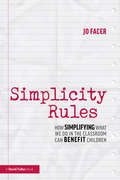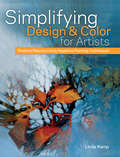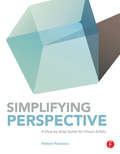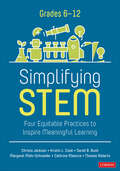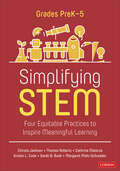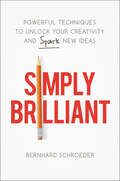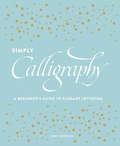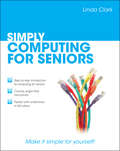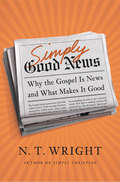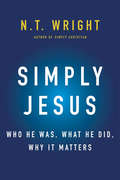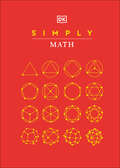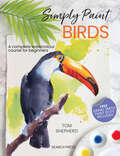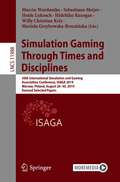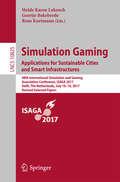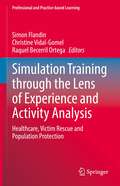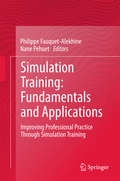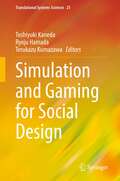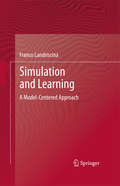- Table View
- List View
Simplicity Rules: How Simplifying What We Do in the Classroom Can Benefit Children
by Jo FacerTeaching: the best job in the world. Yet, increasingly, it is considered one of the toughest professions. In recent years, practices have arisen and become widespread which overcomplicate teaching and increase teacher workload, while only having a marginal impact on pupil learning. Simplicity Rules explores how children learn and the most effective ways to teach them, focusing on achieving results using strategies that are low effort and high impact, along with a comprehensive framework underpinning the ideas. Covering what to teach, talk, practice, starting a lesson, ending a lesson, and feedback alongside practical methods to reduce workload as well as simpler and clearer systems to support teachers in the long term, this book asks: Is this the very best use of my time as a teacher? What is the learning impact for the child? What is the impact on my own workload? Are the results worth this effort? Promoting a simplification of teaching practices, Simplicity Rules is an essential guide for school teachers of all levels of experience, and school leaders.
Simplify Your Writing Instruction: A Framework For A Student-Centered Writing Block
by April SmithSet up your writing block quickly and easily with a simple, research-based framework Schools need their writing instruction simplified. Most classrooms share writing time with another subject, making it difficult for students to receive the direct writing instruction they need. Between the lack of time, increased gaps in writing skills, and inconsistent writing curriculum, teachers are struggling to bring their students up to grade level. Simplify Your Writing Instruction provides you with a classroom-tested framework that helps you set up your writing block within the limited time and resources you have. Step by step, this practical guide shows you how to amplify your students’ writing skills, employ simple feedback opportunities and interventions, streamline your lessons, use simple differentiation techniques to help reach students of all ability levels, and more. Author April Smith is a former teacher who has trained more than 50,000 K-12 educators on best practices for writing instruction. While in the classroom, she learned that having simple and consistent systems in place is critical. Accordingly, none of the tasks and strategies will require you to create or prep anything complicated or time-consuming. In Simplify Your Writing Instruction, you will find easy-to-use checklists, implementation tasks, customizable templates, student writing samples, helpful tables and charts, and a simple spreadsheet that you can use to plan your lessons and modify your teaching to meet the needs of each writer. Be confident and supported in your writing instruction. Simplify Your Writing Instruction will teach you how to: Implement the Simple Pre-Assessment Process in your classroom Encourage authentic writing practice at home Differentiate your lessons to reach your Special Education, ELL, and Gifted students Integrate grammar naturally and optimize student output after each lesson Split the writing process into efficient and effective 10- to 15-minute mini-lessons Make writing a priority by incorporating writing application into other subjects Use a simple pre-assessment to get a better overall picture of what your students can do Utilize more complex strategies such as small group work and conferring Packed with expert advice and easy-to-follow strategies, Simplify Your Writing Instruction: A Framework for a Better Writing Block is a must-have resource for all K-12 educators and teachers in training.
Simplifying Design & Color for Artists: Positive Results Using Negative Painting Techniques
by Linda KempWhen you become a better designer and colorist, you become a better painter. Painting doesn't have to be complicated to be good. In fact, it shouldn't be. Artist and best-selling author Linda Kemp (Watercolor Painting Outside the Lines) bypasses all the complexities of design and color to focus on a fresh, simplified strategy for success that features negative painting--a method that uses the space around your subject to help define it. Improve your painting step by step with projects and exercises that will help your work stand out from the crowd. With Simplifying Design & Color for Artists, you'll learn: Strategies for creating simple yet effective compositions, focusing on the relationship between shape, space, and color. Useful tips on color--how to simplify it, mix your own, and work with value, hue and intensity. Techniques for designing with shape: size and edge, layering, and building dimension and movement. 18 step-by-step projects in watercolor and acrylic. The approach may be simple, but your art will be spectacular!
Simplifying Perspective: A Step-by-Step Guide for Visual Artists
by Robert PastranaMaster the art of linear perspective. If you’re an animator, illustrator, comic book artist, game artist or anything in between, you need to be able to create images that accurately and realistically show space, dimension and form. Simplifying Perspective is the one and only guide that thoughtfully and clearly breaks down the principles of perspective into something that’s easy to understand and use. With approachable lessons and clear visual step-by-step instruction, Robert Pastrana provides you with powerful techniques that help you turn a troubled drawing into a living, breathing, dimensional scene. With Simplifying Perspective, you’ll never have to wade through dense, complex technical manuals again – this comprehensive guide to perspective is tailored specifically for artists who need to learn the ins and outs of one, two, and three-point perspective, measuring, shadows, reflections, and more. Simplifying Perspective presents complex drawing concepts in an easy-to-follow, approachable manner so you can finally learn the essentials of perspective without the anticipated frustration. Provides clarity, depth, and a wealth of examples – this is your must-have guide to understanding and using linear perspective Detailed visual instruction includes hundreds of color coded, step-by-step diagrams that allow you to easily follow the technical process of each construction Comprehensive companion website includes additional resources on perspective with a range of work to help further your skills
Simplifying STEM [6-12]: Four Equitable Practices to Inspire Meaningful Learning (Corwin Mathematics Series)
by Sarah B. Bush Kristin L. Cook Margaret J. Mohr-Schroeder Christa Jackson Oliver Roberts Cathrine MaiorcaStart, focus, or extend your integrated STEM education journey with an authentic interdisciplinary perspective! In response to calls for active STEM learning that builds students’ agency and sense of belonging, teachers and leaders are being encouraged more and more to equitably implement integrated STEM instruction. This practical guidebook is designed to help educators create integrated STEM learning experiences that are inclusive for all students and allows them to experience STEM as scientists, innovators, mathematicians, creators, engineers, and technology experts! Addressing the STEM status quo and promoting inclusiveness in STEM fields, the authors center their work around the Equity-Oriented Conceptual Framework for STEM Literacy, which provides high-quality integrated strategies to connect students′ lived experiences to STEM learning. Simplifying STEM provides a ground-breaking model of the four Integrated STEM Practices (ISPs) to ensure coherent and aligned teaching across disciplines through authentic opportunities to meaningfully engage students. Learn how to simplify STEM with these four equitable practices to inspire deep learning Use critical and creative thinking to seek solutions Collaborate and use appropriate tools to engage in iterative design Communicate solutions based on evidence and data Recognize and use structures in real-world systems Including a STEM planning guide as well as instructional strategies and assessments for standard alignment, this is an essential resource for any educator seeking to empower their students with meaningful STEM learning experiences. The book includes an online implementation toolkit to give educators opportunities for powerful professional development built on collaboration and connection.
Simplifying STEM [6-12]: Four Equitable Practices to Inspire Meaningful Learning (Corwin Mathematics Series)
by Sarah B. Bush Kristin L. Cook Margaret J. Mohr-Schroeder Christa Jackson Oliver Roberts Cathrine MaiorcaStart, focus, or extend your integrated STEM education journey with an authentic interdisciplinary perspective! In response to calls for active STEM learning that builds students’ agency and sense of belonging, teachers and leaders are being encouraged more and more to equitably implement integrated STEM instruction. This practical guidebook is designed to help educators create integrated STEM learning experiences that are inclusive for all students and allows them to experience STEM as scientists, innovators, mathematicians, creators, engineers, and technology experts! Addressing the STEM status quo and promoting inclusiveness in STEM fields, the authors center their work around the Equity-Oriented Conceptual Framework for STEM Literacy, which provides high-quality integrated strategies to connect students′ lived experiences to STEM learning. Simplifying STEM provides a ground-breaking model of the four Integrated STEM Practices (ISPs) to ensure coherent and aligned teaching across disciplines through authentic opportunities to meaningfully engage students. Learn how to simplify STEM with these four equitable practices to inspire deep learning Use critical and creative thinking to seek solutions Collaborate and use appropriate tools to engage in iterative design Communicate solutions based on evidence and data Recognize and use structures in real-world systems Including a STEM planning guide as well as instructional strategies and assessments for standard alignment, this is an essential resource for any educator seeking to empower their students with meaningful STEM learning experiences. The book includes an online implementation toolkit to give educators opportunities for powerful professional development built on collaboration and connection.
Simplifying STEM [PreK-5]: Four Equitable Practices to Inspire Meaningful Learning (Corwin Mathematics Series)
by Sarah B. Bush Kristin L. Cook Margaret J. Mohr-Schroeder Christa Jackson Oliver Roberts Cathrine MaiorcaStart, focus, or extend your integrated STEM education journey with an authentic interdisciplinary perspective! In response to calls for active STEM learning that builds students’ agency and sense of belonging, teachers and leaders are being encouraged more and more to equitably implement integrated STEM instruction. This practical guidebook is designed to help educators create integrated STEM learning experiences that are inclusive for all students and allows them to experience STEM as scientists, innovators, mathematicians, creators, engineers, and technology experts! Addressing the STEM status quo and promoting inclusiveness in STEM fields, the authors center their work around the Equity-Oriented Conceptual Framework for STEM Literacy, which provides high-quality integrated strategies to connect students′ lived experiences to STEM learning. Simplifying STEM provides a ground-breaking model of the four Integrated STEM Practices (ISPs) to ensure coherent and aligned teaching across disciplines through authentic opportunities to meaningfully engage students. Learn how to simplify STEM with these four equitable practices to inspire deep learning Use critical and creative thinking to seek solutions Collaborate and use appropriate tools to engage in iterative design Communicate solutions based on evidence and data Recognize and use structures in real-world systems Including a STEM planning guide as well as instructional strategies and assessments for standard alignment, this is an essential resource for any educator seeking to empower their students with meaningful STEM learning experiences. The book includes an online implementation toolkit to give educators opportunities for powerful professional development built on collaboration and connection.
Simplifying STEM [PreK-5]: Four Equitable Practices to Inspire Meaningful Learning (Corwin Mathematics Series)
by Sarah B. Bush Kristin L. Cook Margaret J. Mohr-Schroeder Christa Jackson Oliver Roberts Cathrine MaiorcaStart, focus, or extend your integrated STEM education journey with an authentic interdisciplinary perspective! In response to calls for active STEM learning that builds students’ agency and sense of belonging, teachers and leaders are being encouraged more and more to equitably implement integrated STEM instruction. This practical guidebook is designed to help educators create integrated STEM learning experiences that are inclusive for all students and allows them to experience STEM as scientists, innovators, mathematicians, creators, engineers, and technology experts! Addressing the STEM status quo and promoting inclusiveness in STEM fields, the authors center their work around the Equity-Oriented Conceptual Framework for STEM Literacy, which provides high-quality integrated strategies to connect students′ lived experiences to STEM learning. Simplifying STEM provides a ground-breaking model of the four Integrated STEM Practices (ISPs) to ensure coherent and aligned teaching across disciplines through authentic opportunities to meaningfully engage students. Learn how to simplify STEM with these four equitable practices to inspire deep learning Use critical and creative thinking to seek solutions Collaborate and use appropriate tools to engage in iterative design Communicate solutions based on evidence and data Recognize and use structures in real-world systems Including a STEM planning guide as well as instructional strategies and assessments for standard alignment, this is an essential resource for any educator seeking to empower their students with meaningful STEM learning experiences. The book includes an online implementation toolkit to give educators opportunities for powerful professional development built on collaboration and connection.
Simply Brilliant: Powerful Techniques to Unlock Your Creativity and Spark New Ideas
by Bernhard SchroederDiscover the powerful techniques that unlocks your creativity and spark new ideas, which will ultimately lead you to continuous business success.Do you label yourself as &“just a numbers person&”? Do you pigeonhole your capabilities to merely that of an analyst or other &“non-artist&”? Stop feeding yourself these lies and learn how even you can tap into the creative genius driving Silicon Valley&’s success stories and begin brainstorming innovation solutions to your company&’s challenges.Using his CreativityWorks framework, creativity and innovation expert Bernhard Schroeder explains how to break out of your self-imposed mental box, reignite natural curiosity, and move step by step through a set of exercises that help individuals and teams.In Simply Brilliant, you will learn how to:Fuel creativity through tight deadlines;Create more ideas in brainstorming sessions;Radically improve products;Find inspired solutions using tools such as IdeaGen, SCAMPER, Tempero, and the Phoenix List;Let go of the &“I&’m not creative&” mindset;And open the door to imagination and limitless opportunity!Even a &“numbers person&” like you can capture markets with your company&’s next innovative idea.
Simply Calligraphy: A Beginner's Guide to Elegant Lettering
by Judy DetrickThis little guide to hand lettering proves that calligraphy is as easy as picking up pen and paper. Focused on calligraphy's most popular alphabet--italic--this delightful manual introduces basic capital and small letters and numbers, plus all the creative flourishes you need to customize your unique script for every project and occasion. With quick and easy instruction from calligraphy teacher and designer Judy Detrick, Simply Calligraphy will have you whipping up elegant invitations, pleasing place cards, and personalized thank-you notes in no time.From the Trade Paperback edition.
Simply Computing for Seniors (Simply #18)
by Linda ClarkStep-by-step instructions for seniors to get up and running on a home PC Answering the call for an up-to-date, straightforward computer guide targeted specifically for seniors, this helpful book includes easy-to-follow tutorials that escort you through the basics and shows you how to get the most out of your PC. Boasting an elegant, full-color interior with a clean, sophisticated look and feel, the layout makes it easy for you to find the information you need quickly. Author Linda Clark has earned her highly respected reputation through years of teaching computers at both the beginning and intermediate levels. She uses this experience in the field to deliver you a comprehensive resource that shares everything you need to know about working with a computer. Guides you through working with computers so you can reach a level where you feel comfortable and confident Shows you how to find your way around Windows 7 and Microsoft Office 2010 Teaches you how to e-mail, get online, use Internet banking, book holidays, shop online, and more Walks you through sharing photos and watching movies Features numerous examples and illustrations SIMPLY Computing for Seniors puts you on your way to becoming a savvy computer user today!
Simply Digital Photography
by Rob SheppardIf you are serious about digital photography, then this clear, concise guide is the ideal companion for fast and efficient learning.Simply Digital Photography offers techniques that can be used to make better digital photos, prints, and photo-based projects. Full-colour screen shots and numbered, step-by-step instructions show readers how to use their equipment, compose the best shot, and even make edits to photos to create stunning images and produce better photos.The simple, yet elegant design features a multitude of images as well as tips & tricks to make this a perfect reference for all ages - just follow the instructions with your camera and set your own speed.Packed with photos and illustrations, this visual tutorial is excellent value for money. Learn something new today - read it, try it and become your own expert with Simply Digital Photography!
Simply Good News: Why the Gospel Is News and What Makes It Good
by N. T. WrightDiscover the Real Story Jesus Came to AnnounceMany people think the message of the gospel is that if we believe in Jesus we will be saved from hell and be transported to heaven after we die. But what if that is not what the Bible actually teaches? What if the good news Jesus came to announce is much bigger, much better, and includes much more than merely what happens after we die? Revered bestselling scholar N. T. Wright reveals what the gospel really is and how it can transform our todays just as much as our tomorrows.
Simply Jesus: A New Vision of Who He Was, What He Did, and Why He Matters
by N. T. WrightWe have grown used to the battles over Jesus-whether he was human or divine, whether he could do miracles or just inspire them, whether he even existed. Much of the church defends tradition, while critics take shots at the institution and its beliefs. But what if these debates have masked the real story of Jesus? What if even Jesus's defenders have been so blinded by their focus on defending the church's traditions that they have failed to grapple with what the New Testament really teaches? Bible scholar, Anglican bishop, and bestselling author N. T. Wright summarizes a lifetime of study of Jesus and the New Testament in order to present for a general audience who Jesus was and is. In Simply Jesus, we are invited to hear one of our leading scholars introduce the story of the carpenter's son from Nazareth as if we were hearing it for the first time. "Jesus-the Jesus we might discover if we really looked," explains Wright, "is larger, more disturbing, more urgent than we had ever imagined. We have successfully managed to hide behind other questions and to avoid the huge, world-shaking challenge of Jesus's central claim and achievement. It is we, the churches, who have been the real reductionists. We have reduced the kingdom of God to private piety; the victory of the cross to comfort for the conscience; Easter itself to a happy, escapist ending after a sad, dark tale. Piety, conscience, and ultimate happiness are important, but not nearly as important as Jesus himself." As the church faces the many challenges of the twenty-first century, Wright has presented a vision of Jesus that more than meets them.
Simply Math (DK Simply)
by DKUnderstanding math has never been easier.Combining bold, elegant graphics with easy-to-understand text, Simply Math is the perfect introduction to the subject for those who are short on time but hungry for knowledge. Covering more than 80 key mathematical theories from prime numbers and matrices to logarithms and quadratic equations, each pared-back, single-page entry explains the concept more clearly than ever before.Organized by major themes – number theory and systems; algebra, arithmetic, and calculus; probability and statistics; geometry and topology; logic, game theory, and computer science – entries demystify the groundbreaking ideas of famous mathematicians such as Pythagoras, Pierre de Fermat, Fibonacci, and Henri Poincaré, explaining the essentials of each key mathematical theory.Whether you are studying math in high school or college, or simply want a jargon-free overview of the subject, this indispensable guide is packed with everything you need to understand the basics quickly and easily.
Simply Paint Birds: A Complete Watercolour Course For Beginners
by Tom ShepherdUnlock the world of contemporary watercolour bird painting with popular artist and dynamic teacher, Tom Shepherd.Free Daniel Smith paint dot card included to get you started immediately!Painting birds doesn't have to be technical or daunting, even for a complete beginner. Through friendly advice and clear instructions, expert artist and tutor Tom Shepherd will show you how to paint 26 dynamic, colourful birds in 8 steps each, including:EaglesFlamingosOwlsMacaw parrotsRed CardinalsToucansRobins If you’re a complete beginner, simply follow the projects in order to learn how to handle watercolour in achievable, rewarding steps. You will build essential skills while producing impressive results right from the start. Meanwhile, if you’re a confident hobby artist, you can dip in and out wherever you wish.Tom's step-by-step process for each bird is simple and achievable, and uses just a few watercolour paints and a handful of brushes. His style is fresh and contemporary, and his clear instructions will allow you to achieve the same loose, dynamic results.
Simply Paint Flowers: 25 Inspiring Designs in Easy Steps
by Becky AmeliaBe amazed at how easily you can paint beautiful flowers in simple steps.Artist Becky Amelia shares her easy-to-follow approach to painting, with a range of beautiful flowers in her distinctive and contemporary style.Using only a few brushes and a small collection of watercolour and gouache paints, this book will inspire you with 25 stunning step-by-step projects to paint, including single flowers, leaves, wreaths and bouquets. Learn to paint sunflowers, tulips, poppies, lilies, wildflower arrangements, dried flowers and many more pretty stem arrangements.Feel inspired by Becky's intricate and delicate style and create beautiful floral paintings that you too could turn into gorgeous notecards, stationery, gifts or to keep as lovely, framed paintings.
Simply by Grace: An Introduction to God's Life-Changing Gift
by Charles C. BingSimply by Grace is an easy-to-read introduction to a core Christian belief. By looking at the major questions and issues that surround the concept of grace, Charles C. Bing helps readers understand and appreciate this God-given gift and how simple it really is.
Simulation Gaming Through Times and Disciplines: 50th International Simulation and Gaming Association Conference, ISAGA 2019, Warsaw, Poland, August 26–30, 2019, Revised Selected Papers (Lecture Notes in Computer Science #11988)
by Hidehiko Kanegae Marcin Wardaszko Sebastiaan Meijer Heide Lukosch Willy Christian Kriz Mariola Grzybowska-BrzezińskaThis book constitutes revised selected papers from the 50th International Simulation and Gaming Association Conference, ISAGA 2019, which took place in Warsaw, Poland, during August 26–30, 2019.The 38 papers presented in this volume were carefully reviewed and selected from 72 submissions. They were organized in topical sections named: simulation gaming in the science space; simulation gaming design and implementation; simulation games for current challenges; simulation games and gamification; and board perspective on simulation gaming.
Simulation Gaming. Applications for Sustainable Cities and Smart Infrastructures: 48th International Simulation And Gaming Association Conference, Isaga 2017, Delft, The Netherlands, July 10-14, 2017, Revised Selected Papers (Theoretical Computer Science and General Issues #10825)
by Heide Karen Lukosch Geertje Bekebrede Rens KortmannThis book constitutes the refereed post-conference proceedings of the 48th International Simulation and Gaming Association Conference, ISAGA 2018, held in Delft, The Netherlands, in July 2018. The 19 revised full papers included in the volume were carefully reviewed and selected from 27 submissions. The contributions to this book range from design thinking related to simulation gaming, the analysis of the consequences of design choices in games, to games for decision making, examples of games for business, climate change, maritime spatial planning, sustainable city development, supply chain, and much more.
Simulation Training through the Lens of Experience and Activity Analysis: Healthcare, Victim Rescue and Population Protection (Professional and Practice-based Learning #30)
by Simon Flandin Christine Vidal-Gomel Raquel Becerril OrtegaThis book offers various ways in which analyzing professional experience and activity in simulation training makes it possible to describe practice-based learning affordances and processes. Research has been conducted in various simulation programs in the domains of healthcare, victim rescue and population protection, involving healthcare workers, firemen, policemen, servicemen, and civil security leaders. "Work-as-done" (/ "training-as-done") in simulation has been analyzed with ergonomics, occupational psychology, and vocational training approaches. The authors describe and discuss theoretical, methodological, and/or practical issues related to practitioner experience and activity in simulation training. The book also provides evidence on the conditions under which lived experience in simulation can foster or hinder learning, and derives appropriate orientations for simulation design and implementation.
Simulation Training: Fundamentals and Applications
by Philippe Fauquet-Alekhine Nane PehuetDrawing on decades of industrial experience, this insightful and practical guide uses case studies and an interdisciplinary perspective to explain the fundamentals of simulation training to improve performance of high-risk professional activities. It seeks to identify those conditions under which simulation training has been shown to improve professional practice while employing extensive real examples. Simulation Training: Fundamentals and Application helps readers to develop their own synthesis of the simulation learning method and to use such training to enhance their skills and performance. Case studies demonstrate five specific theatres of professional practice - the nuclear-power industry, aeronautics, surgery, anesthesia and metallurgy - and then detailed analysis highlights the common factors and key results. The author's background as a Human Factors Consultant, Physicist and Physiologist has enriched studies of humans in work situations, work organization and management and he has also been involved in pedagogical conception of experimental training on simulators based on his experience as a safety expert on nuclear power plant. The book is useful to practitioners, researchers and students, both in industry and in university. It is clearly cross disciplinary as it presents and discusses applications in engineering, professional practice (airline pilots) and medicine.
Simulation and Gaming for Social Design (Translational Systems Sciences #25)
by Toshiyuki Kaneda Ryoju Hamada Terukazu KumazawaThis book is a collection of research articles that deal with three aspects of simulation and gaming for social design: (1) Theory and methodology, including game system theory and agent-based modeling; (2) Sustainability, including global warming and the energy–food nexus);; and (3) Social entrepreneurship, including business, ethnic, and ethical understanding. The latter two especially form two major areas of clinical knowledge in contemporary life. Simulation and gaming, with its participatory approach, provides participants with a seamless integration of problem solving and education. It has been known as a tool for interdisciplinary communication since the 1960s, and now it is being developed to contribute to global society in the twenty-first century. This is the first book on simulation and gaming for social design that covers all aspects from the methodological foundations to practical examples in the fields of sustainability and social entrepreneurship. Regardless of the size of the problematics, societal system design involves (1) The visioning and conception aspects due to the long-term, overall nature of the goal; (2) Interdisciplinary thinking and communication for the exploration of new states of accommodation with technological systems; and (3) The “human dimension” aspect including education that must be dealt with, thus academic developments of simulation and gaming for social design as system thinking and practice methodologies are anticipated. Simulation and gaming has great potential for development as a tool to facilitate the transfer between theoretical and clinical knowledge.
Simulation and Learning
by Franco LandriscinaThe main idea of this book is that to comprehend the instructional potential of simulation and to design effective simulation-based learning environments, one has to consider both what happens inside the computer and inside the students' minds. The framework adopted to do this is model-centered learning, in which simulation is seen as particularly effective when learning requires a restructuring of the individual mental models of the students, as in conceptual change. Mental models are by themeselves simulations, and thus simulation models can extend our biological capacity to carry out simulative reasoning. For this reason, recent approaches in cognitive science like embodied cognition and the extended mind hypothesis are also considered in the book.. A conceptual model called the "epistemic simulation cycle" is proposed as a blueprint for the comprehension of the cognitive activies involved in simulation-based learning and for instructional design.
Simulation and Learning: A Model-Centered Approach
by Franco LandriscinaThe main idea of this book is that to comprehend the instructional potential of simulation and to design effective simulation-based learning environments, one has to consider both what happens inside the computer and inside the students' minds. The framework adopted to do this is model-centered learning, in which simulation is seen as particularly effective when learning requires a restructuring of the individual mental models of the students, as in conceptual change. Mental models are by themeselves simulations, and thus simulation models can extend our biological capacity to carry out simulative reasoning. For this reason, recent approaches in cognitive science like embodied cognition and the extended mind hypothesis are also considered in the book.. A conceptual model called the "epistemic simulation cycle" is proposed as a blueprint for the comprehension of the cognitive activies involved in simulation-based learning and for instructional design.
